1850 Isaac Frampton Buys and Sells Property for Burlington 37
You can read the deed from Isaac Frampton, naming James Twyman’s slaves here.
While not directly related to Chesapeake’s History, this next story is a testament to the courage and conviction of the Frampton Family. On the other hand, when Isaac Frampton began helping the African Americans come to the free state of Ohio, did he get into something deeper than he imagined? Helping slaves across the Ohio River into Ohio was a serious crime in 1849. Why did he take that risk? I want to learn more about Isaac Frampton.
From 1849 to 1850, Isaac took on the role of land agent for the Executors of the late James Twyman, a wealthy Virginian who owned a vast plantation with enslaved people in Madison County, Virginia. He never married and never had any children, but he left a will that stipulated the emancipation of his slaves. Many are familiar with the ‘Burlington 37,’ but few know the whole story of the legal battles that unfolded behind the scenes in Madison County, Virginia, courtrooms. Here is a summary:
https://www.lva.virginia.gov/chancery/full_case_detail.asp?CFN=113-1852-019#img
James Twyman died in February 1849 in Madison County, Virginia. In James’ will, he appointed his brother Anthony Twyman and his nephew William H. Twyman (the son of his brother Anthony) Executors of his estate.
Also, in his will, Twyman emancipated and set free his slaves, including his invalid slaves, Noah, Winney, and Joe. However, he gave those three slaves two choices. (1) They could receive $3,000 each for their care if they stayed in Virginia, or (2) allow them to move with the others to a ‘free state.’ If the ailing slaves decided to leave Virginia, Twyman directed his Executors to apply $500 each for their removal and relocation in one of the ‘free States’ of the Union and gave them the option to leave with the other slaves. [Spoiler alert: they did come to Lawrence County, Ohio]
In addition, he willed $10,000 to his Executors to be applied for removing his emancipated slaves to one of the ‘free States’ to purchase a home or homes for them with provisions and clothing for one year. An interesting bit of information found in this lawsuit: James Twyman didn’t specify which ‘free state’ he was referring to in his will. This decision was left entirely to the Executors. So why did they choose Lawrence County, Ohio? Let’s investigate that further as we read the lawsuit by Twyman’s heirs.
Alfred I. Twyman and Nancy Willis et al. filed a lawsuit against the Executors of James Twyman &c in Madison County, Virginia. [Chancery Records, pages 1-167.] The dispute began on 1 June 1850, with the final agreement on May 1852. Exhibit (A) in this court case was James Twyman’s will, a long and complicated document to which he had added many codicils and additions.
According to this Chancery record, James Twyman’s heirs were quite upset when the Executors took a trip in 1850 to the slave-free state and county of Lawrence County, Ohio, to scout for property, in which they were gone several weeks. [Most of the complaints in the lawsuit were about the wheat fields that Twyman owned. I will explain why that is important later.]
This story gets quite confusing, so let me explain and pay close attention to the dates and the amount of money.
- First, the deed was incorrectly written at the Lawrence County, Ohio, Recorder’s Office Deed Book 12, page 137. On 31 October 1849, Isaac and his wife Jane Frampton of Wayne County, Virginia, transferred ownership to Simeon, Violet, and others for $6,000. [According to the lawsuit, the Executors came to Lawrence County, Ohio in 1850]
- Second, the clerk wrote below Simeon, Violet, and others, [the buyers of the property] “James Ferguson Emancipated Slaves of.“ I believe this was intentionally written under James Ferguson instead of James Twyman to hide the fact Isaac Frampton was ‘giving’ the slaves property he already owned. This way, there would be no trace of James Twyman’s slaves coming to Ohio.
- Third, the deed says the slaves paid $6,000 for this property [what happened to the other $5,150?].
- Fourth, in the description, there is a very small detail that most have overlooked. It states the property to the north was previously owned by Yaegar [which was underlined] but is now owned by George Kouns. In rechecking the deeds in Lawrence County, Ohio, no property was listed by anyone named Yaegar [different spelling were checked] between 1818 and 1863. Well, why is that important?
In the lawsuit by James Twyman’s heirs, we find a Hiram Yager who testified that he knew Dr. William H. Twyman and that he went to the ‘free state’ of Ohio in 1850 for several weeks, looking for property for Twyman’s slaves. Yager further testifies that he saw the receipt for some money, which he paid the state of Ohio after his return. [The Executor paid Isaac Frampton according to a later document filed in the Recorder’s Office]
The receipt was supposed to have been from Isaac Frampton, who sold Twyman’s Executors 640 acres of property in Fayette Township, Lawrence County, Ohio. But there wasn’t a receipt. In Deed Book 12, page 343, on 15 March 1850, a ‘receipt‘ is quickly recorded at the Recorder’s Office in Burlington, Ohio, nearly six months after the deed was recorded. This document reads:
Anthony Ferguson & William H. Ferguson. [The clerk marked through those two names and handwrote beside that] “Slaves of James Ferguson to James Ferguson, Executor. Receipt in full of Bequest.” It is dated 15 March 1850, and beside that is written “Receipt” where it usually would say “Deed.” This whole record is filled with discrepancies. The Executor William H. Twyman records his name was William H. Ferguson. The other Executor, Anthony Twyman, records his name as Anthony Ferguson. [Notice there isn’t any reference to Isaac Frampton]
Continuing with the document in Deed Book 12, page 343, ‘receipt,’ it reads: “According to the 9th Section of James Twyman’s will, the slaves received $2,669.00 in full of the $11,000.00 in moving them to the State of Ohio and the expenses in purchasing lands, tools, etc.” [Really? Did they get that money? The slaves couldn’t read or write, so they would never know they were supposed to get an inheritance of money]
The names of the slaves were named, and the recorded ‘receipt‘ was notarized by Elias Nigh on 15 March 1850 in Lawrence County, Ohio. On that date, each slave placed their mark [X] beside their written name, proving they couldn’t write their name and probably couldn’t read. This document was then quickly recorded in the Recorder’s Office the next month, 15 April 1850. [which was unheard of being recorded so quickly in those days.]
I believe James Twyman had already had some connection with Isaac Frampton before his death through Mr. Yaegar. They had to come up with a story to get the slaves from Virginia to Ohio safely and make certain they would be free. It is most likely that Twyman knew his relatives would contest his will, so he secretly made arrangements to ensure they were taken care of.
Was it any wonder that Isaac owned most of this property? Issac could quickly make out a deed in their names and then move the freed slaves to Burlington, Ohio.
Why did Isaac Frampton suddenly leave the free state of Ohio and move to the slave state of [West] Virginia right before this sale was made? He must have known of the impending lawsuit over the will. Why was that such an issue for the heirs? Because the slaves were the ones who worked in those fields, and with the harvest coming, the heirs certainly didn’t want to harvest the fields!!
Did Isaac trade some of James Twyman’s slaves for property he already owned? That is possible because the 1850 Wayne County, VA Slave Schedule, dated 4 September 1850, shows Isaac living in the slave state of Virginia (now West Virginia) with five slaves in his household. The above story reveals the extent to which the enslaved people would go for their freedom, plus they had many people helping them escape through the “Underground Railroad.”
I am sure there is a lot more to this story, but I will leave with what I have researched. If I find additional information in the future it will be added to this page.
From James Twyman’s Estate Papers in Madison County, Va., concerning his will. The receipt mentioned was undoubtedly made from Isaac Frampton, who purchased the property for the Burlington 37.
From James Twyman’s Estate Papers in Madison County, Va., concerning his will
The newspaper article above pertains to James Twyman’s estate, which was involved in a lawsuit with Twyman’s heirs concerning the Burlington 37 property. Isaac Frampton’s daughter, Rebecca Frampton, married Charles F. Everett and lived in Guyandotte, WV: Lynchburg [Virginia] Daily News, 2 Nov. 1855, page 3. I searched numerous places and could never find the deposition of Isaac and Martin Frampton concerning this lawsuit.
1850 Wayne County, (W)VA Slave Schedule
1850 Wayne County, (W)VA census
Did You Know?
In 1826, John Ward, Sr. of Pittsylvania County, Virginia, manumitted 136 enslaved people and provided them to be sent west. The freed individuals registered with the Pittsylvania Court, which required their name, age, physical description, and often family connection. In 1827-1828, forty-eight individuals from this group settled in Lawrence County, Ohio, and were on the 1830 Federal Census. The other eighty-eight persons settled in other Ohio County locations: Gallia, Jackson, Ross, Pike, Highland, and Clinton. SOURCE: Freedom Lies Across the River, by Carrie Eldridge, 2022, page 19.
The 1850 census shows Noah and Vinney Twyman living with the rest of their family in Lawrence County, Ohio. They are buried in the Burlington 37 Cemetery in Burlington, Ohio. As far as Joe, the other invalid slave, I found no record of him in Lawrence County, Ohio, 1850 census. However, his name is listed on the monument located at the Burlington 37 Cemetery.
Isaac Frampton Sr. Will Cabell County, WV Will Book 2, page 313
Isaac Frampton Sr. Will Cabell County, WV Will Book 2, page 314
Isaac Frampton Jr. Will Cabell County, WV Will Book 2, page 347



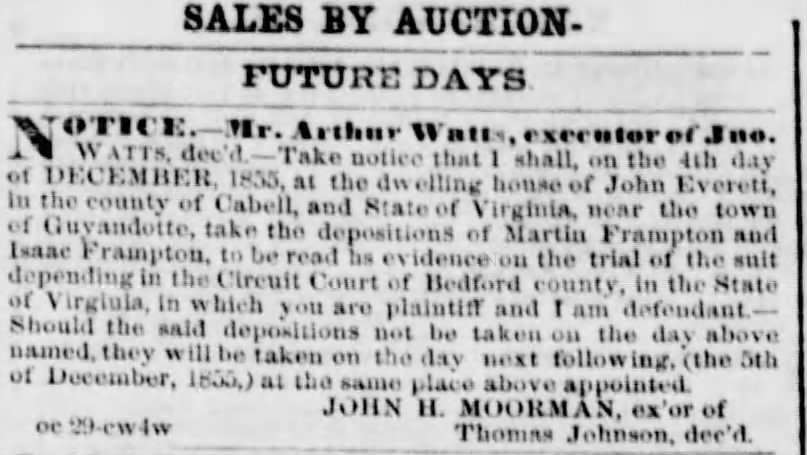
![1850WayneCoVaSlaveSchIsaacFrampton 1850 Wayne County, [W]VA Census of Slave Schedule](https://lawrencecountyohio.com/wp-content/uploads/2024/05/1850WayneCoVaSlaveSchIsaacFrampton.png)
![1850WayneCoVaCensusIsaacFrampton 1850 Wayne County, [W]VA census](https://lawrencecountyohio.com/wp-content/uploads/2024/05/1850WayneCoVaCensusIsaacFrampton.png)

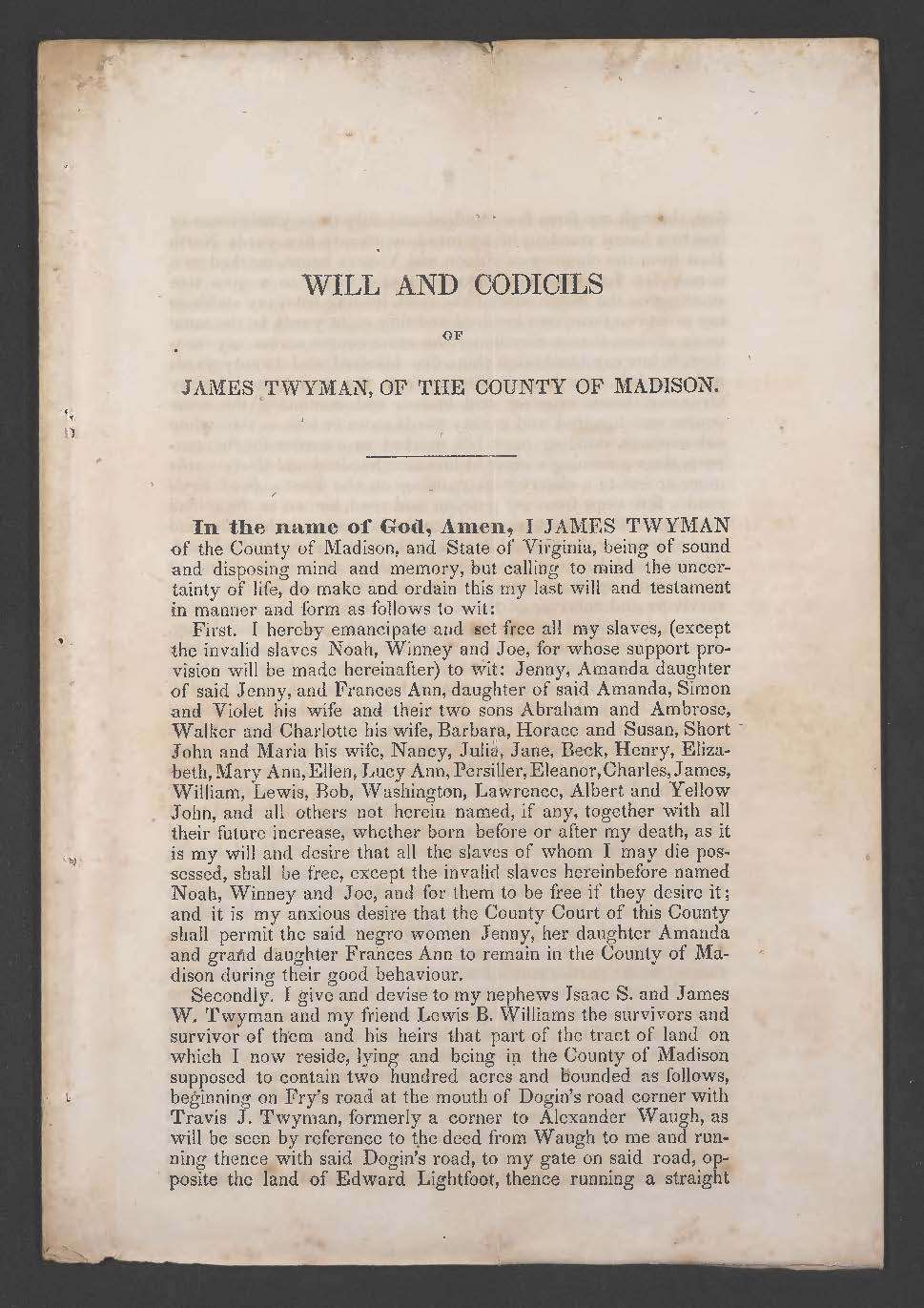
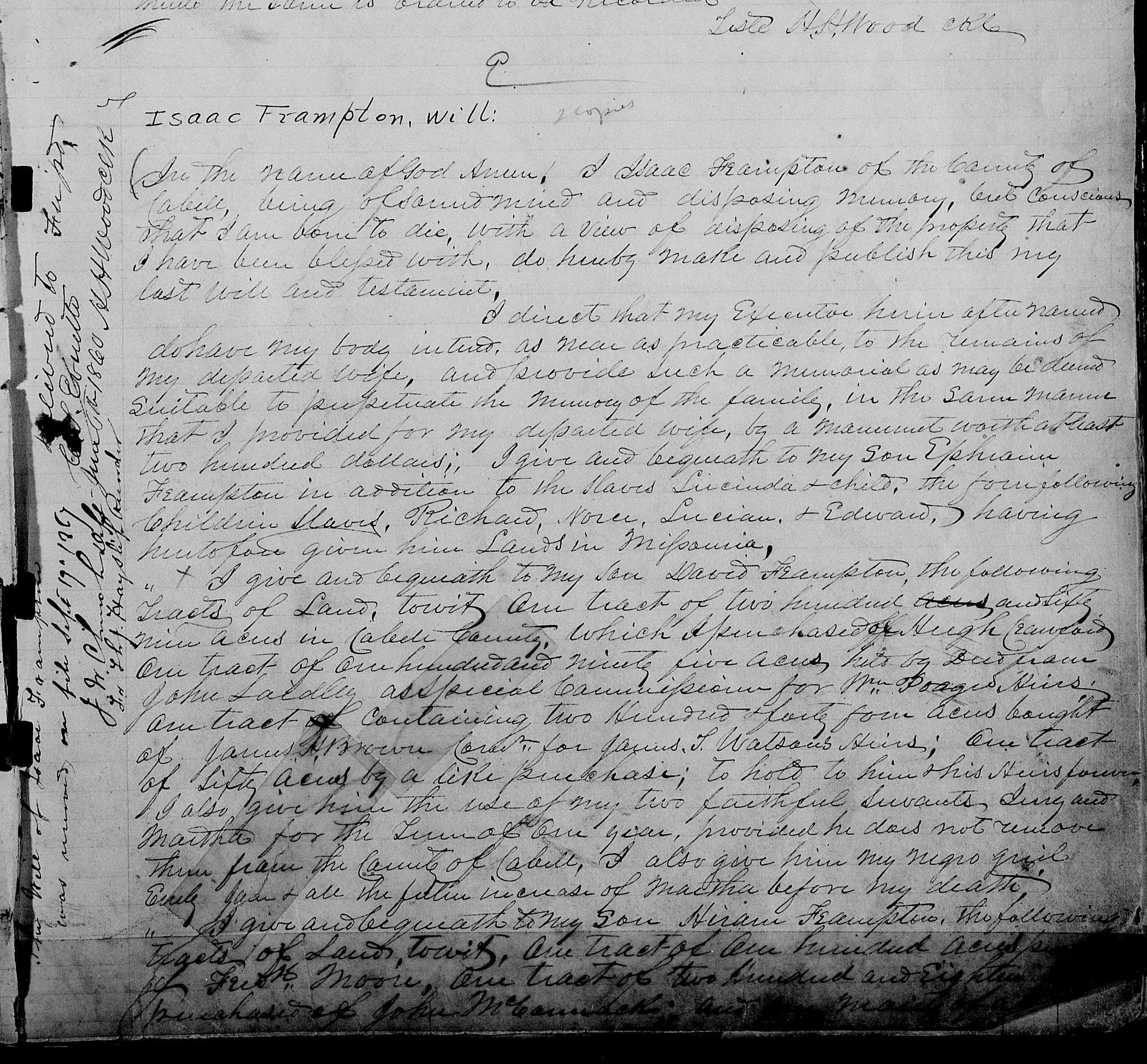
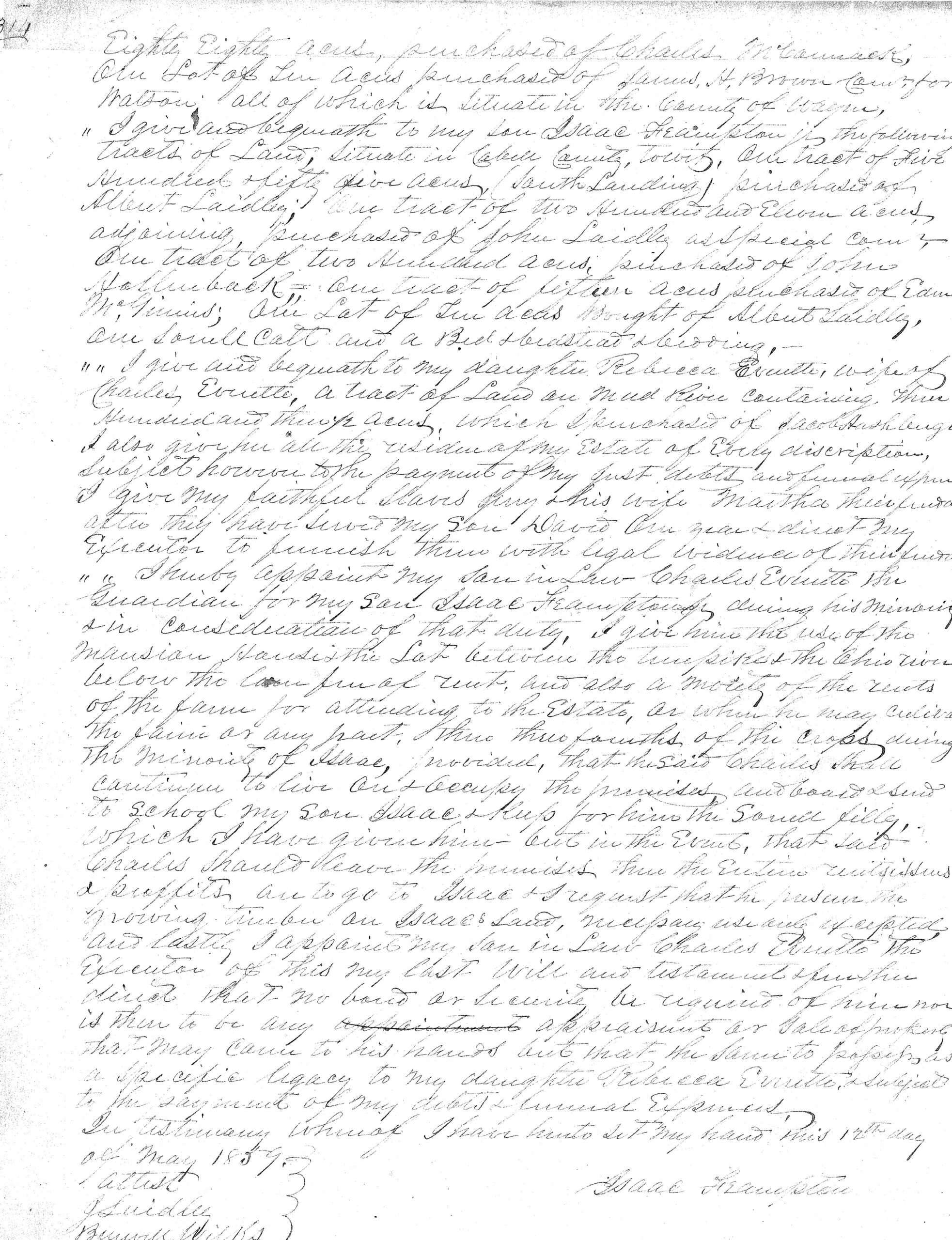
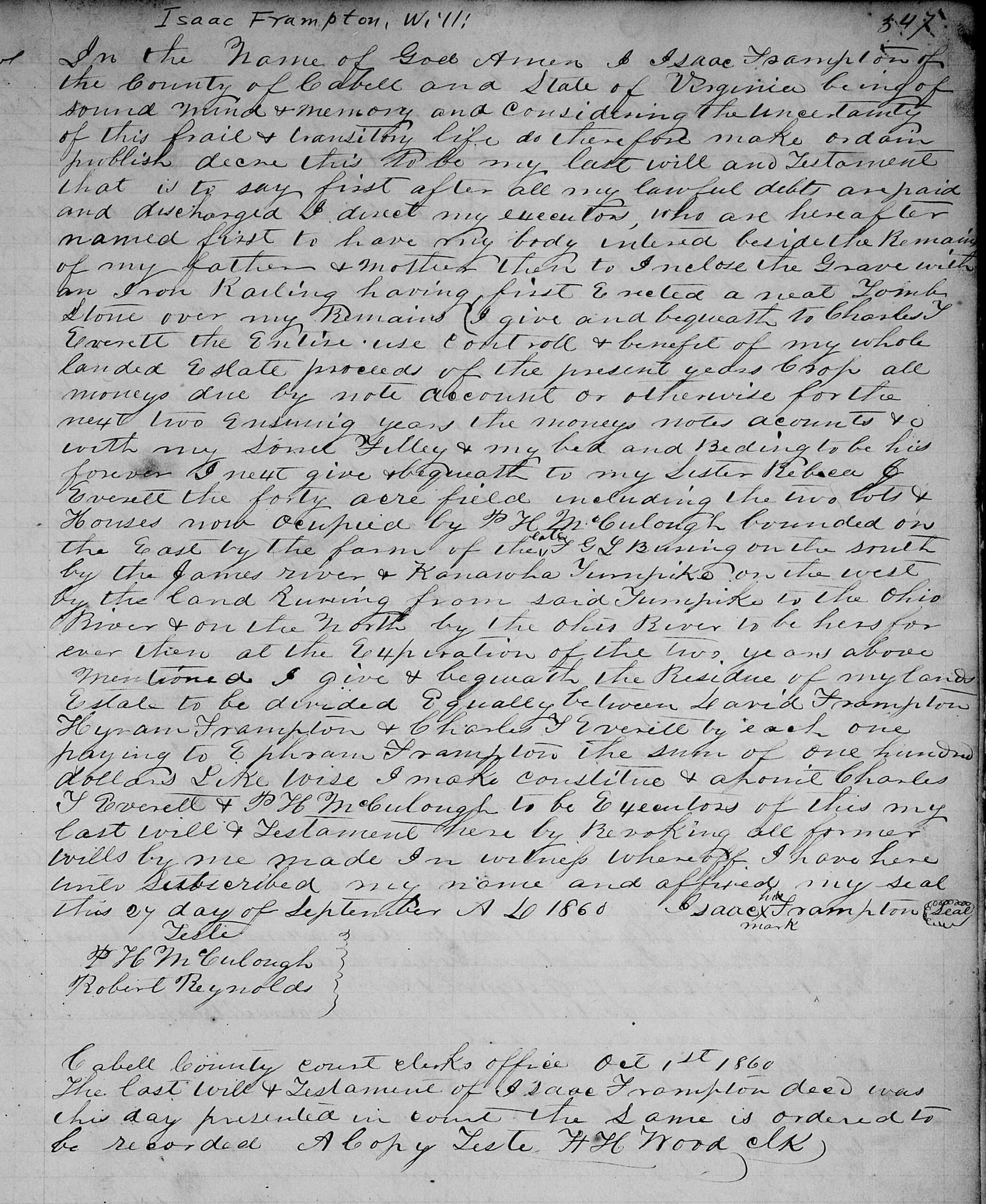
Thank you, Diane,
That story is one that you have to digest and sort through. It was very difficult to write and make it easy to understand at the same time. If you find anything that needs correcting, please let me know. I want my book to be factual for future generations.
Martha
Well, Martha, you’ve done it again. Thank you for sharing all of this information. Isaac Frampton, maternal 4th great granduncle, had his hands in a few things. I need to re read it a couple of times to be sure I have the details straight.
Thanks again,
Diane